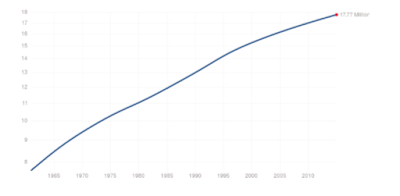Poverty: an Integration Issue – Part 2 – The Case of Chile
I will not dwell much on the poverty issues of Chile, since I do not have enough
information. But let’s take a look at the basics. As we have seen before, Chile was
not as open to European migration as Argentina. This results in 30% of the
population is of Caucasian origin; Mestizos with predominant Caucasian ancestry
are estimated to amount a total of 65%, while Native Americans (or Amerindians)
comprise the remaining 5%. Interesting that, if asked, most Chileans identify
themselves as “white”. Nobody wants to be associated with indigenous people after
all.[16] See the fantastic growth Chile has had based on GDP x capita over the last 40
years. It has gone up 15 times!!! Some people refer to it as the “Chilean miracle”.
However, has it spread throughout the entire population? Poverty levels have been
almost halved from 1990 to 2000, however, 20% of the population today remain
under the line of poverty, which climbs to 40% if included the cash transfers and
subsidies provided by the State to achieve incomes above poverty line (people [17][18]) We can also see that population doubled in Chile from the
1970s until today.
Regardless of Chile’s superfluous growth and stable economic performance,
differences between classes remain high. The Gini Index, which measures
inequality, locates Chile in the 50% range, whereas Argentina is in the 42%
(similar to the US). This obeys mainly two reasons: 1. Argentina has a much stronger public healthcare and educational system,
accessible to anyone. Chile has a long way to go in that direction.
2. Argentina has a much larger amount of “Caucasians”. So, even if society is
also segregated, the levels of segregation do not reach those of Chile.
Conclusion: The problem of inequality is not exclusively based on state measures,
but racism and discrimination usually triumph over government efforts. In
Argentina, the battle between “Europeans” vs. “Indians” persists even today, based
of course on ethnical background. Chile, with a higher degree of “Indians” presents
even more segregation issues. Whatever the statistics say, the truth is that
Argentina, because of it’s multi-european background, is a much more equalitarian
society than Chile. It presents more opportunities for the every-day citizen, as well
as the largest and most educated middle class in Latin America. Regardless of
OECD statistics or what the New Liberal British Magazine “The Economist” has to
say, Argentina is without a doubt, a more developed country than Chile.
http://www.ilo.org/wcmsp5/groups/public/---ed_protect/---protrav/---travail/documents/publication/wcms_248029.pdf
https://www.ohchr.org/EN/NewsEvents/Pages/DisplayNews.aspx?NewsID=15749&LangID=E








No comments:
Post a Comment